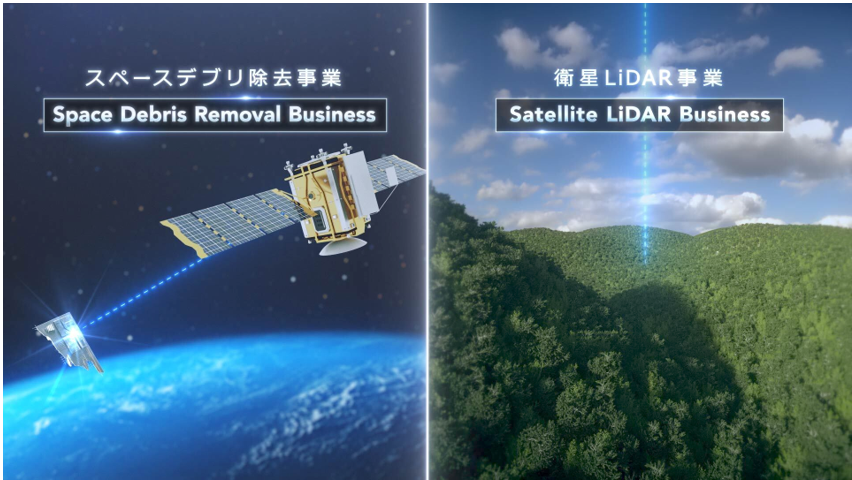As inter-satellite laser links help fuel the rapid expansion of the largest constellations the world has ever seen, a traditional satellite operator wants to put stronger lasers to work clearing the debris that LEO megaconstellations risk leaving behind.
Sky Perfect JSAT, Japan’s flagship geostationary satellite operator, announced the creation of a startup in January that would use in-orbit lasers to stabilize tumbling space junk and put it on course to burn up in the Earth’s atmosphere.
The venture, Orbital Lasers, is developing spacecraft that would fire a laser at a defunct object, ablating material on the surface to generate thrust for changing its orientation and location.
The venture is led by Tadanori Fukushima, who joined Sky Perfect JSAT as an engineer nearly two decades ago. Sky Perfect JSAT has an undisclosed stake in Orbital Lasers alongside other unnamed shareholders.
The project began as an internal startup program in 2018 and counts Japanese state-backed laser technology developer RIKEN as its main industrial partner. RIKEN, or Institute of Physical and Chemical Research, set up a Satellite Orbital State Control Laser Laboratory nearly four years ago to design and develop the laser-equipped spacecraft in partnership with Nagoya University and Kyushu University.
Japan’s space agency has also supported early-phase concept studies for the satellite and ground systems.
A Sky Perfect JSAT spokesperson said Orbital Lasers is starting with a team of 10 people but plans to grow to 50 to 100 employees as it nears commercial operations.
The startup does not expect to perform active debris removal (ADR) services for commercial constellation operators and governments any sooner than 2029.
However, it plans to have a laser payload as early as March 2025 that it could sell to Astroscale, ClearSpace, Rogue Space Systems, or another robotic debris-cleaning venture just getting started, to use for stabilizing a tumbling object, making a capture and de-orbit mission easier.
An ADR customer would integrate the laser payload into their servicer, but Orbital Lasers would operate the de-tumbling service, the spokesperson told SpaceNews.
Depth of field
Japan-based Astroscale declined to comment on any interest in Orbital Lasers’ proposed capability. Astroscale chief technology officer Mike Lindsay said rapidly tumbling debris poses an additional challenge and safety concern for capture, but Astroscale has its own tools for tackling this.
In a U.K.-funded demonstration mission launching in 2026, Lindsay said Astroscale will use a method called “plume impingement,” whereby it would use the servicer’s thruster plume to gently slow a tumbling object down to a rate that is better for safe capture.
“This is done from a fair distance, of course, so as to not damage the debris with excessive aerodynamic forces,” he said.
Rogue Space Systems, based in the United States, would also not comment specifically on Orbital Lasers.
Rogue CEO Jon Beam said it is working toward a 2026-2027 in-orbit demo that could use magnets to stabilize and de-orbit debris, depending on the thrust level of a propulsion system it is developing, and sees “contactless detumbling as a core tactic in any safe in-space servicing, ADR, or in-space logistics missions.”
Luc Piguet, CEO of Switzerland’s ClearSpace, said a laser detumbling payload could be of interest, if the performance, mass, and power budgets made sense.
“Deorbiting a large object with laser only would require a lot of time, but there have been some interesting detumbling demonstrations in lab environment using lasers,” he said.
As well as being able to down debris without risking physical contact, the Sky Perfect JSAT spokesperson said its servicers would only need electricity from their solar panels to power the lasers, whereas some robotic servicers would require extra fuel to tow space junk back toward Earth.
To help fund the plans, the startup also has plans for satellites that would be fitted with LiDAR (Light Detection and Ranging) technology, which NASA and other organizations use for highly precise 3D-image scans of the Earth’s surface.
Sky Perfect JSAT signed a study contract with Japan’s space agency Jan. 12 to help commercialize the proposed Earth observation LiDAR capability. Sky Perfect JSAT, which counts 17 satellites in a geostationary fleet that provides regional broadband and TV services, said Orbital Lasers would be the first commercial company to offer an ADR service using space-based lasers if successful.
Last year, a three-year-old Japanese startup called EX-Fusion said it had raised around $13 million in seed funding to develop ground-based lasers that could be used to shoot down space debris.
This article first appeared in the February 2024 issue of SpaceNews magazine.
Related
Read the original article here
